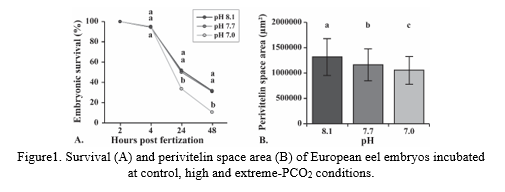CO2/PH IMPACTS THE SURVIVAL OF EUROPEAN EEL Anguilla anguilla EMBRYOS WHEN INCUBATED IN RECIRCULATION AQUACULTURE SYSTEMS
Introduction
Considerable efforts have been made in the past years towards closing the European eel life cycle in captivity (Tomkiewicz et al., 2019), including enhanced environmental conditions for embryonic and larval culture (Politis et al., 2017, 2018). Still, effects of pH fluctuations on eel early life stages remain unknown. Fish embryos and larvae are expected to be particularly sensitive to pH changes, as organs for pH regulation are not fully developed (Ishimatsu et al., 2008). The aim of this study was to evaluate the sensitivity of eel embryos to fluctuations in pH/CO2 and identify the developmental timing and functionality of related regulatory pathways.
Materials and methods
Following a standardized gamete production and fertilization protocol (Tomkiewicz et al., 2019), European eel embryos were moved to three custom designed RAS units supplying upwelling incubators. Embryos were incubated at optimal temperature and salinity and at three different PCO2/pH conditions: (1) control-PCO2 (400 µatm CO2, pH 8.1), (2) high-PCO2 (1000 µatm, pH 7.7) and (3) extreme-PCO2 (3000 µatm, pH 7.0). Embryonic survival was assessed at 4, 24, and 48 hours post-fertilization (hpf). Samples of embryos were taken at 24 hpf for morphological measurements, and at 24 and 48 hpf to determine the expression levels of 11 target genes: hsp70 and hsp90, involved in physiological stress/repair response; aqp1 and aqp3, which are water and solute transporters; nkcc1a, ncc and car15, involved in acid-base regulation; crfr1 and crfr2, that mediate in responses to stress; and GABAAα6b and GABAAα12, related to inhibitory neurotransmission.
Results
Survival was similar for all pH/CO2 conditions at 4 hpf. At 24 hpf and onwards, survival significantly declined at extreme PCO2 compared to the control and high PCO2 treatment (Fig. 1A). The egg diameter at 24 hpf was smaller at high and extreme PCO2 with a related reduction of the perivitelline space (Fig. 1B). The expression of aqp3, hsp70, crfr2 and ncc significantly increased from 24 to 48 hpf, although they were not affected by the pH/PCO2 treatments. Conversely, crfr1, GABAAα6b and GABAAα12 expression, decreased over time for all treatments. Finally, the expression levels of aqp1, hsp90, car15, and nkcc1a genes were similar across treatments and developmental times.
Discussion
At increased pCO2 levels, egg swelling was impaired resulting in a reduction in egg size. Here, high concentrations of H+ may have an inhibitory effect on colloidal processes leading to a reduction in water uptake during perivitelline space formation (Eddy & Talbot, 1983). This could negatively affect the embryos ability to osmoregulate and therefore lead to increasing mortality as was observed for the high and extreme PCO2 conditions. Such stressful conditions, are expected to lead to upregulation of heat shock proteins (Roberts et al., 2010). In European eel embryos, hsp70 and hsp90 expression was unaffected by changes in PCO2, even though these genes are upregulated in response to salinity and thermal stress in early larval stages (Politis et al., 2017, 2018). Similarly, crfr1 and crfr2 transcription levels, genes also involved in stress response, were not affected by acidification. Expression of crfr2 increased in all treatments from 24 to 48 hpf, whereas crfr1 showed an opposite trend. This is similar to what was observed for zebrafish embryos, which relates to their inability to synthesise cortisol until after hatching (Alderman & Bernier, 2009). On the other hand, the expression of acid-base regulatory genes was similar for all treatments. Here, nkcc1 and CA15 expression remained constant, but ncc increased towards 48 hpf suggesting an important role in osmoregulation in late developmental and early larval stages. In conclusion, the underlying mechanisms investigated in this study, seem to be under development during early embryonic ontogeny and thus not yet matured to regulate a molecular response to acidification. Nevertheless, these findings show that exposure to high PCO2 conditions can impair normal development in this species and should be controlled in order to optimize European eel culture.
References
Alderman SL & Bernier NJ (2009). Ontogeny of the corticotropin-releasing factor system in zebrafish. Gen Comp Endocr, 164:61-69
Eddy FB & Talbot C (1983). Formation of the perivitelline fluid in Atlantic salmon eggs (Salmo salar) in fresh water and in solutions of metal ions. Comp Bioch Phys C, 75:1-4
Ishimatsu A, Hayashi M & Kikkawa T (2008). Fishes in high-CO2, acidified oceans. MAR Ecol Prog Ser, 373:295-302
Roberts RJ, Agius C, Saliba C, Bossier P & Sung YY (2010). Heat shock proteins (chaperones) in fish and shellfish and their potential role in relation to fish health: a review. J Fish Dis, 33:789-801
Politis SN, Mazurais D, Servili A, Zambonino-Infante JL, Miest JJ, Sørensen SR, ... & Butts IA (2017). Temperature effects on gene expression and morphological development of European eel, Anguilla anguilla larvae. PLoS One, 12:e0182726
Politis SN., Mazurais D, Servili A, Zambonino-Infante JL, Miest JJ, Tomkiewicz J & Butts IA (2018). Salinity reduction benefits European eel larvae: Insights at the morphological and molecular level. PloS one, 13:e0198294
Tomkiewicz J, Politis SN, Sørensen SR, Butts IAE, Kottmann JS (2019). European eel – an integrated approach to establish eel hatchery technology in Denmark. In Eels Biol Monit Manag Cult Exploit Proc First Int Eel Sci Symp. 340-374
